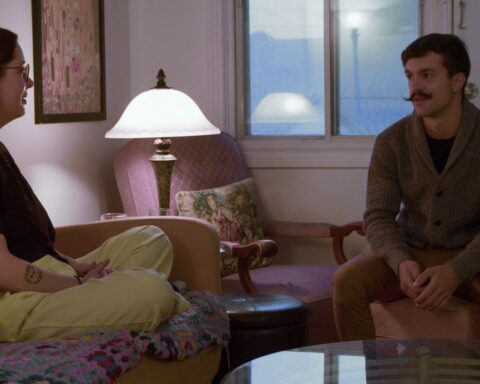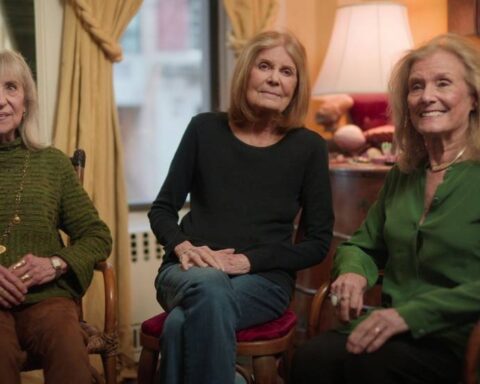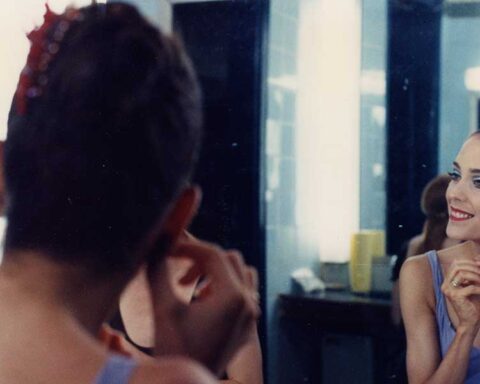The death of Peter Harcourt on July 3rd of this year, at the age of 82, from a variety of ailments, was neither tragic nor unexpected. The eminent scholar, critic and professor had been retired from his final teaching post at Carleton University in Ottawa for nearly two decades, and his failing health was not a secret to his friends and colleagues. Yet the news still resonated in the scattered outposts of Canadian film culture. Few things join people of different tastes and temperaments together like a sense of a collective debt. You’d be hard-pressed in 2014 to find anybody who writes about, teaches, programs or produces Canadian cinema who doesn’t owe something to Peter Harcourt.
In his 1994 autobiography, A Canadian Journey: Conversations in Time, Harcourt described himself as a “one man film institute,” a grand designation nevertheless edged with a sense of humility. This slim but invigorating volume, written when its author was 63 years old, stands as a premature magnum opus; while he concludes the book by passing the torch of cinematic scholarship and education to a younger generation, Harcourt would live another 20 years and add plenty of material to a body of work simply unrivalled in his country’s history of film criticism. But even though he makes a point of gazing, with guarded optimism, into the future, Harcourt seems interested primarily in looking back, not only on his great accomplishments but also on his follies and his flaws, all of which he explains are intimately connected to his status as one of the first, and by extension, one of the loneliest, heroes of Canadian film culture.
“Ideally, Peter Harcourt would be considered within Canadian film culture the way that Margaret Atwood is revered in our literary culture,” says Geoff Pevere, who studied Canadian cinema at Carleton University in the late 1970s at the height of Harcourt’s heyday as a lecturer and scholar, and also at a time when it was still something of a novelty to discuss homegrown work within the academy. “What I mean by that is that like Atwood, he identified certain distinguishing characteristics and patterns in our national cinema. They may not seem to apply as much to our contemporary movies, but they gave us the ground on which to build the entire discussion in the first place.”
In an obituary for Harcourt in The Globe and Mail, Pevere said that his former teacher “entirely rearranged the furniture in [his] tiny undergrad intellectual flat,” a beautifully vivid turn of phrase which enfolds Harcourt’s image as a pedagogical icon with the force and authority of his writings on Canadian cinema. A passionate advocate of both English- and French-Canadian auteurs, from the rebellious (Don Owen) to the poetic (Jean Pierre Lefebvre), who argued equally for the work’s significance on the international stage and its value to Canadian viewers who might otherwise pass it by, Harcourt’s great
achievement was to direct attention toward what he called “an invisible cinema.” That phrase was at once a paradox—cinema is a visual medium—and a challenge to students and scholars alike to look harder, until the films and their unique qualities came into focus.
One of the high ironies of Harcourt’s career is that he had to go to the United Kingdom in order to discover his role as a crusader on behalf of Canadian cinema. Born in Toronto in 1931 and educated at the University of Toronto, Harcourt was a talented musician who opted to study literature at Cambridge. While in England, he began to write and report regularly on cinema, including a stint working for the British Film Institute, where he happened upon a cache of National Film Board cinema verité productions. In A Canadian Journey, Harcourt writes that his admiration for these films re-oriented more than his perspective. “From the aspect of self-recognition that [they] provided, I wanted to return home.”
That homecoming would be a staggered process beginning with Kingston, Ont., and Queen’s University where, following an invitation from the English department, Harcourt set up what is acknowledged as the first film studies department in Canada. Among his students was director Peter Raymont, who recalls the aura of excitement that attended the professor’s arrival on campus. “Film was a very hot subject in 1969,” he says. “It was like the literature of the new generation. Peter would sit during his lectures with his feet on the back of the chair, and he was very articulate. When you talked with him one on one, you got the feeling that he was really listening to you. And he wasn’t judgmental.” Raymont has a good story on that last point: after Harcourt caught him breaking into the so-called “Film House” on Seward Street to use the editing equipment after hours, he offered the younger man a key to access the facilities around the clock.
There was another impressionable teenager lurking around Film House in those days, even though he wasn’t there to study film: Piers Handling, the director and CEO of the Toronto International Film Festival (TIFF) and probably Harcourt’s most famous protégé. “I hung out around the department a lot,” he says. “It was an exciting time: Peter was there, and so was Robin Wood, and they brought all these filmmakers to show their work—Arthur Penn, Peter Watkins, Jean Pierre Lefebvre. Film House had its own identity, which was very cool. It was different than the rest of the university. It felt very non-bureaucratic.”
Handling was one of several people interviewed for this story who implied that “non-bureaucratic” was an apt descriptor for Harcourt in general—that despite his facility as a lecturer and his popularity with students, he was never totally comfortable within institutional structures. This professional restlessness might account for Harcourt’s departure from Queen’s in 1974 to the Slade School of Fine Art in London, England, and then later that same year to York University in Toronto, but it also had something to do with his critical philosophy. Harcourt’s excellent study Six European Directors, which included analyses of work by Sergei Eisenstein, Jean Renoir, Luis Bunuel, Ingmar Bergman, Federico Fellini and Jean-Luc Godard, was published in 1974, right in the middle of an ideological shift in film studies, the intervention of semiotics into what had previously been considered a humanist discourse. Harcourt’s evaluative, impressionistic and intensely personal film criticism was now out of fashion, and while he was received warmly back in Toronto—including at the CBC, which commissioned him to do a series of reports on various national cinemas, and at the early iteration of TIFF, the Festival of Festivals, where he did work for a few years as a programmer—he was on the move again in 1978, to Carleton University in Ottawa.
“For me, Peter was a de-colonizer of the mind,” says Tom McSorley, who, like Pevere, was a student at Carleton in 1978, and who, like Pevere, Handling, Raymont, and so many of Harcourt’s other students, has gone on to do his share of shaping the discourse on Canadian cinema, most recently as the director of the Canadian Film Institute in Ottawa. “And not just at the level of nationalism, but also at the academic level of doubting and investigating the fashions and orthodoxies of film studies and film theory.”
For York University professor and graduate program director Brenda Longfellow, who was a rookie instructor at Carleton in those days, Harcourt wasn’t just an intellectual influence. He was a generous colleague who welcomed her into the faculty and his home: she lived in his basement for three months. Like McSorley, she believes that the turn in film studies in the 1970s toward critical theory was discombobulating for a scholar who had always sought to catalogue expressive artistry. “He wasn’t enamoured of Screen theory or high structuralism. He would take me to task for being too dogmatic or rhetorical, and then in the last few pieces I showed him, he told me that I’d sort of grown up.”
This is the other common denominator among all of the people I spoke to about Harcourt—that even as his students grew up and in some cases gained more notoriety and influence than he ever had, he followed their careers with interest and pride. And he was always willing to offer feedback. Filmmaker Michael Ostroff, who first met Harcourt during the legendary free Friday night film screenings at Carleton in the late 1970s, says that they became close friends a few decades later, and that he would show Harcourt his work even while he was still ankle-deep in the editing process. “After 20 weeks of cutting, we’d show it to Peter and worry that he’d thought it was terrible! Because his reactions were so internal. He didn’t give you an immediate response because he was really trying to absorb what was happening in the film.”
Harcourt’s desire to give marginal or difficult films the attention that they deserved—even in the case of a filmmaker like David Cronenberg, whose artistic temperament he adjudged too chilly for his tastes—led some to see him as a cheerleader of sorts for Canadian cinema. It’s a term that doesn’t necessarily have to be pejorative. Perhaps Harcourt’s greatest curatorial success was the championing of Canadian cinema at the 1984 Festival of Festivals. With the help of Handling and Pevere, Harcourt created an annual showcase, Perspective Canada, and assembled a landmark retrospective of over one hundred Canadian shorts and features. It was a culmination of Harcourt’s espousal of this country’s cinema.
Harcourt continued writing and editing for the next two decades, including an essential essay collection on his beloved director Jean Pierre Lefebvre, whose work he claimed “combine[d] the formal authority of Michael Snow with the compassionate humanity of Jean Renoir”—a dialectic that also neatly sums up the author’s own twin passions for experimental and classical cinema. But he never became a mainstream icon like Jay Scott or Brian Linehan, who had the advantages of national bylines and network face time, respectively. “I think the fact that Peter never had a regular journalistic platform is why it seemed to a lot of people like he’d disappeared [after his retirement],” says Pevere. “I can say that he maintained a very active social life, which involved people coming to visit him, in the ‘Court of Harcourt.’ I made a point of travelling to Ottawa once a year to visit with him.”
A Canadian Journey is a book that weighs Harcourt’s passion for the spiritually nourishing qualities of art against his skepticism about an “ascendant culture of distractive entertainment.” He believed that the “consumptive culture cannot continue,” and while in this he has so far been proven incorrect, his belief that things would eventually improve marks him as an optimist as well as a realist—a paradox that fits into what Handling describes as a “mass of contradictions.” If the best critics are the ones who force us to test our own responses to a work of art—both against our prejudices and assumptions as well as the work of art itself—Peter Harcourt’s often self-divided writing makes him valuable in a way that outstrips smoother, glibber writers: patient, methodical and endlessly questioning rather than asserting, he didn’t make the job of film scholarship look easy (nor should it be). If re-reading Peter Harcourt’s body of work can make it feel at times like he was examining Canada and its Two Solitudes from his own lonely place, it’s also finally deeply affirmative. It broaches the possibility that cinema is not just a tourist destination, fit for a few hours’ escape, but a place where even the most far-flung among us can come home.
Harcourt said as much, near the end of A Canadian Journey: “Investigating these matters, one works like an archaeologist, burrowing amongst the remnants of a past civilization that, on examination, one recognizes as one’s own.” In studying the films of his once and future homeland, he saw a reflection of himself, which is fair enough since for the past half-century, Canadian cinema has seen itself remade, time and again, in Peter Harcourt’s image.









